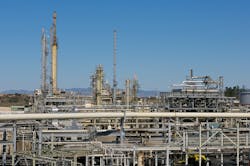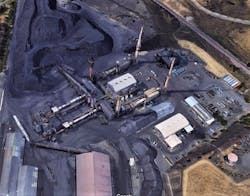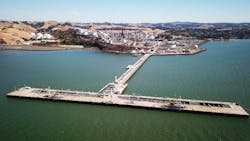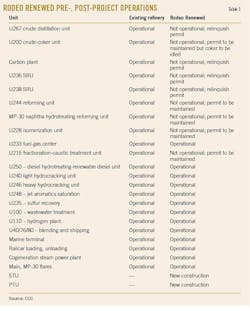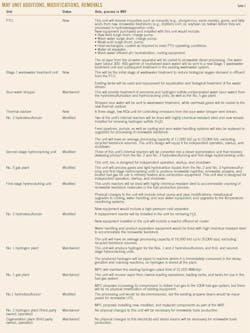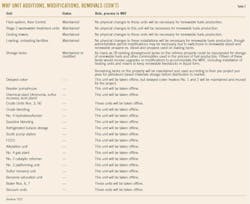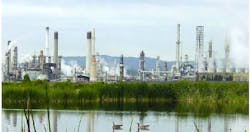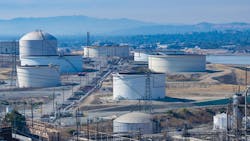Northern California refineries set for sitewide conversion to renewables
Phillips 66 Co. and Marathon Petroleum Corp. (MPC) are moving ahead with projects to permanently eliminate processing of crude oil at their refineries in northern California’s San Francisco Bay area by converting the sites to production of renewable, drop-in transportation fuels using a mix of bio-based feedstocks.
Concurrently granted official approvals to proceed with construction by California’s Contra Costa County’s (CCC) board of supervisors in early May, MPC’s Martinez Renewable Fuels (MRF) project at the now-idled Martinez, Calif., refinery and Phillips 66’s Rodeo Renewed project at the 120,000-b/d portion of its San Francisco refining complex in Rodeo, Calif., each will involve a combination of new unit additions as well as modifications to existing processing units to enable processing of strictly renewable, nonhydrocarbon resources (OGJ Online, May 6, 2022).
Part of the refiners’ commitments to decarbonizing their individual operations while still competitively meeting rising regional demand for low-carbon fuels in line with the global energy transition, the Bay Area refinery-to-renewables conversion projects also will support California’s latest revision to its climate-action plan calling for drastic reductions to statewide use of fossil fuels as a means of achieving carbon neutrality by 2045 or sooner.
This article presents an overview of the operators’ updated and regulator-approved plans for the northern California refinery-to-renewables conversions based on CCC’s recent certifications of the projects’ respective final environmental impact reports (EIR) and land-use permits under the California Environmental Quality Act (CEQA). In addition to detailing site-specific plans for the refineries’ overhauls, the article includes a brief discussion of California’s existing and pending regulatory frameworks incentivizing the refiners’ transition away from traditional hydrocarbon processing at the Bay Area manufacturing complexes.
Shared objectives, difficulties
Announced months apart in 2020 amid severe reductions in demand for finished petroleum products resulting from the coronavirus (COVID-19) pandemic’s impact on northern California’s economy, the Phillips 66 and MPC proposed refinery conversion plans essentially share the same core objectives, CCC said in official project documents.
To ensure long-term viability and competitiveness of their California operations as regional demand for fossil-based fuels continues to gradually decline, the operators designed the Rodeo Renewed and MRF projects to eliminate the processing of crude feedstocks in a way that would preserve employment and assist California in achieving its renewable energy and environmental protection goals by switching the refineries’ production slates to low-carbon, cleaner-burning fuels that reduce regional greenhouse gas emissions (GHG), particulate matter, and other pollutants as the state accelerates its shift to a clean-energy economy, according to the projects’ individual EIRs.
The refinery-to-renewables conversions also provide the operators’ opportunities to benefit under US federal as well as state regulations and market-based approaches incentivizing reductions to overall GHG emissions, which in California include the California Low Carbon Fuel Standard (LCFS) and cap-and-trade programs.
While Rodeo Renewed and MFR received requisite approvals based on CEQA-mandated environmental reviews from the CCC Planning Commission in March 2022, approvals for both projects—despite their intent to altogether eliminate crude processing at the sites—faced subsequent appeals by regional interest groups, those appeals were denied at a May 3 special meeting of CCC’s board of supervisors, which granted final certifications and approvals, respectively, for the projects EIRs and land use permits.
Phillip 66’s Rodeo Renewed
First announced on Aug. 12, 2020, Phillips 66’s proposed $850-million Rodeo Renewed project will involve construction of new and repurposing of existing units to enable production of renewable fuels from a feedstock of waste oils, fats, greases, and vegetable oils the operator will source from local, US domestic, and international suppliers (Fig. 1).
To decontaminate and condition renewable feedstocks secured via marine, rail, and truck deliveries to the site, Phillips 66 will build a new pretreatment unit (PTU)—with recovery equipment for recyclable fats, oils, and grease (FOG)—that, once completed, will feature three processing trains designed to treat a broad range of renewable feedstocks, including, but not limited to:
- Used cooking oil (UCO).
- FOG.
- Tallow (animal fat).
- Inedible corn oil.
- Canola oil.
- Soybean oil.
- Other vegetable-based oils.
- Emerging, next-generation feedstocks.
In addition to FOG recovery, the PTU’s decontamination process for removing metals and other solids that could compromise the repurposed hydroprocessing units’ ability to produce renewable transportation fuels will include a combination of vacuum drying, adsorption, filtration, and centrifugal separation, according to Phillips 66. Initially, the PTU will consist of only two processing trains equipped with a pretreating capacity of about 53,000 b/d, with a third train to be added later that would boost total treating capacity to 80,000 b/d. Addition of the new PTU also will require installation of piping to connect to storage tanks and process units.
The PTU additionally will incorporate a vapor collection and treatment system consisting of a biofilter followed by an activated carbon adsorption bed. The biofilter would reduce most odor constituents from the collected vapor, with any residual components discharged from the biofilter to be further removed via the activated carbon bed, according to the project’s EIR.
Immediately adjacent to the refinery’s existing sulfur recovery unit (U235), the renewables project will add a new sulfur treatment unit (STU) that includes a thermal oxidizer, waste-heat boiler, caustic scrubber tower, and fresh and spent caustic tanks to control ammonia and hydrogen sulfide offgases.
To accommodate the refinery’s transition to producing renewable fuels, Phillips 66 will undertake a series of physical modifications and operational changes to existing processing units at the site.
On the U240 hydrocracker, works will involve:
- Replacing two existing reactor vessels at end of life.
- Replacing and modifying existing heat exchangers.
- Adding new process-surge vessel, minor-chemical storage tanks, and feed filters.
- Retraying four distillation towers.
At the U246 hydrocracker, the operator will:
- Replace and modify existing heat exchangers.
- Add new exchangers, new minor-chemical storage tanks, a process pump, and feed filters.
- Retray two distillation towers.
At the U110 hydrogen plant, changes will involve installation of new piping, a fuel-gas cooler, and a control-valve station to enable U110’s processing of renewable fuel gas for production of renewable hydrogen.
At the refinery’s rail butane-loading rack, Phillips 66 will convert the existing butane rail-loading stations to receive renewable feedstock by installing new steam-piping connections to warm up and liquefy renewable feed in railcars before they are unloaded.
Since the refinery will no longer be processing crude feedstock upon completion of Rodeo Renewed, Phillips 66 said it will shut down and demolish its nearby Santa Maria refining site in Arroyo Grande, Calif.—which converts heavy crude oil into high-quality feedstock for further processing into gasoline, diesel, and jet fuel at the Rodeo refinery—as well as its on-site carbon plant (Figs. 2-3). Various pipelines currently delivering crude feedstock to the refinery also will be sold or taken out of service following the refinery’s transformation, the operator said.
Once operational, the Rodeo Renewed marine terminal would no longer receive any deliveries of crude and gas oils (Fig. 4).
Table 1 shows a more complete list of process unit changes taking place under the Rodeo Renewed project.
Phillips 66, which announced taking final investment decision to proceed with Rodeo Renewed on May 11, 2022, previously completed startup of a first leg of renewable diesel production in July 2021 from one of the Rodeo refinery’s repurposed hydrocracking units using Topsoe AS’ proprietary HydroFlex technology (OGJ Online, May 12, 2022).
Scheduled to reach commercial operations in first-quarter 2024, Rodeo Renewed will add about 55,000 b/d of renewable diesel, renewable gasoline, and sustainable aviation fuel (SAF) production to the refinery’s existing 12,000-b/d renewable diesel capacity for an overall post-project renewable fuels production of 67,000 b/d, according to the project’s EIR.
Alongside creating 500 construction jobs and preserving more than 650 jobs, including full-time employees and contractors, Phillips 66 said it expects the Rodeo Renewed project will supply enough renewable fuels to reduce regional lifecycle carbon emissions by about 65%—the equivalent of removing 1.4 million cars/year from California roads—while also slashing criteria pollutant emissions and water use at the site by 55% and 160 million gal/year, respectively.
MPC’s MRF
After indicating its interest in evaluating the potential repositioning of the Martinez site into a renewable diesel plant following the former 161,000-b/d refinery’s permanent idling in August 2020, MPC formally filed an application in November 2020 with CCC for a land use permit to advance the MRF refinery-to-renewables conversion project (OGJ Online, Aug. 3, 2020).
Like Rodeo Renewed, the MRF proposes adding new units and removing existing but obsolete units at the site to enable processing of a mix of renewable feedstocks such as soybean oil, corn oil, rendered fats, and other miscellaneous bio-based feedstocks—including UCOs and other vegetable oils—into renewable diesel, naphtha, propane, and treated fuel gas.
MPC would, following minor modifications, continue to use two of its existing marine oil terminals to receive and distribute renewable feedstock and fuels produced as part of the MRF, as well as begin using another MPC-owned terminal nearby. Current truck systems also would remain in use for transportation of MFR’s feedstocks and finished products, while existing pipelines would undergo minor upgrades such as insulation to ensure product remains fluid enough to flow, according to the project’s EIR. Renewable feedstocks also would be supplied via rail into regional third-party terminals but offloaded onto barges or other waterborne vessels for delivery via one of MPC’s existing marine terminals, as the refinery is not equipped to unload raw, renewable resources from trains.
Proposed unit additions at the site would include a renewable feedstock PTU, wastewater treatment equipment, and an advanced three-stage low-nitrogen oxide (NOx) thermal oxidizer. Major equipment scheduled to be removed includes a crude unit, gasoline hydrotreater, alkylation unit, fluidized catalytic cracking unit (FCCU), reformers, delayed coker, steam boilers, among others, according to DCD project documents.
Scheduled for a construction period of about 22 months, MPC said the first of the refinery’s existing units to be modified for the MFR’s production of renewable fuels include conversions of the No. 3 hydrodesulfurizer, the second-stage hydrocracking unit, and the No. 5 gas plant.
Table 2 shows a description of units to be added, modified, and removed as part of the refinery’s conversion to renewable fuels production.
MPC—which, in March 2022, agreed to a 50-50 joint-venture partnership on the $1.2-billion MRF with Neste Corp.—said it expects to begin production of 260 million gal/year of renewable diesel in second-half 2022, and following startup of pretreatment capabilities, reach full nameplate production capacity of 730 million gal/year by yearend 2023 (OGJ Online, Mar. 7, 2022).
Regulatory incentives
On May 10, California Air Resources Board (CARB) released the latest draft plan update under Assembly Bill 32 (AB 32), the California Global Warming Solutions Act of 2006, that—pending final approval in late-June 2022—will guide the state’s transition to a clean energy economy and carbon neutrality no later than 2045.
The third update to the state’s initial 2008 Scoping Plan under AB 32—which created a comprehensive, multiyear framework for reducing California’s GHG emissions—the draft 2022 Climate Change Scoping Plan (CCSP) identifies what CARB outlines as “a technologically feasible, cost-effective, and equity-focused path” for achieving carbon neutrality over the next two decades. CCSP also assesses the state’s progress in cutting GHG emissions by at least 40% below 1990 levels by 2030. Focused on outcomes needed to achieve carbon neutrality by assessing routes for clean technology, energy deployment, and nature-based solutions, the draft 2022 CCSP is designed to meet California’s long-term climate objectives while supporting a range of economic, environmental, energy security, environmental justice, and public health priorities.
Referred to by CARB as its “most comprehensive and far-reaching scoping plan developed to date,” the latest draft plan’s most notable aspect is the aggressive pace and scale it proposes for reducing the state’s reliance on fossil fuels wherever they are currently used in California via regulations, incentives, and carbon pricing already in place for a decade and a half. Central to the plan’s shift away from fossil fuels is an accelerated transition to zero-emission transportation; phased-out use of fossil gas used to heat homes and buildings; and sustainable options for walking, biking, and public transit to reduce peoples’ reliance on cars. Action in the transportation sector will be further supported by accelerating the addition of more affordable and reliable renewable energy to displace fossil fuel-fired electricity generation, as well as by scaling up new options such as hydrogen and renewable gas for hard-to-electrify end uses, according to the draft 2022 CCSP.
The draft 2022 CCSP builds on California’s existing LCFS and cap-and-trade programs that employ systems of market-based motivations and mechanisms aimed at reducing the state’s GHG emissions by encouraging less reliance on petroleum-based fuels and increased investments in cleaner-fuels production and technologies. The approach expands incentives for transitioning the state’s existing petroleum-based fuel production and distribution assets in ways that support deployment of low and zero-carbon fuels while also accommodating remaining in-state demand for hydrocarbon-based fuels to prevent rising imports that could lead to heightened GHG emissions.
Despite California Gov. Gavin Newsom’s September 2020 executive order N-79-20 mandating that 100% of in-state sales of new passenger cars and trucks are zero-emission by 2035, CARB acknowledges in the draft 2022 CCSP that use of internal combustion-engine vehicles will not stop overnight and, therefore, will require traditional fossil fuels until the remaining fleet reaches end of life. Noting the LCFS as the key driver of California’s total consumption of renewable diesel and its coproducts increasing 589 million gal since 2011 to reach about 2.39 million gal in 2011, CARB outlines a strategy for a scaled approach to continued reduction of GHG emissions during phasing out of conventional-fuel usage, including exploration of requiring most remaining petroleum refiners to implement carbon capture and sequestration (CCS) at their operations by 2030.
The agency said it will include ongoing progress and efforts to reduce demand for petroleum fuels and opportunities to phase down oil and gas extraction and refining in its next CCSP update to be released in 2027. CARB’s latest CCSP update also noted that Executive Order N-79-20’s call on state agencies to support the transition of existing fuel production sites away from fossil fuels in a manner that protects and supports workers, public health, safety, the environment, and vulnerable surrounding communities already is under way, fostering a growing alternative fuel market via repurposing of conventional refineries to production of SAF, renewable diesel, and hydrogen. The key to sustaining this trend, said CARB, is to keep sending powerful market signals through policies and programs that continue to encourage private-sector investment in a clean future for California.
About the Author
Robert Brelsford
Downstream Editor
Robert Brelsford joined Oil & Gas Journal in October 2013 as downstream technology editor after 8 years as a crude oil price and news reporter on spot crude transactions at the US Gulf Coast, West Coast, Canadian, and Latin American markets. He holds a BA (2000) in English from Rice University and an MS (2003) in education and social policy from Northwestern University.

